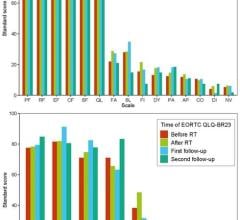
October 27, 2017 — Racial/ethnic disparities in cancer survival in the U.S. are well documented, but the underlying causes are not well understood. To better explain disparities, researchers examined cancer survival by racial/ethnic group for 877,662 patients diagnosed with breast, prostate, colorectal or lung cancer between 2000–2013 using California Cancer Registry data.
In the study published in the Journal of Clinical Oncology, researchers found stage at diagnosis, neighborhood socioeconomic status and marital status to have the biggest impact on racial/ethnic cancer survival disparities.
Black patients had the lowest survival rate for all cancer types and Asian American/Pacific Islander ethnic groups had the highest survival, compared to Whites.
Black patients with breast, prostate and colorectal cancer were more likely to be diagnosed with late stage tumors than Whites, with stage explaining 16-28 percent of overall racial/ethnic survival disparities.
Living in a low socioeconomic neighborhood, far more common among Black and Hispanic patients than among Whites or Asian Americans/Pacific Islanders, explained 5-18 percent of the overall survival disparities among racial/ethnic groups, with the largest contribution for lung cancer.
The most significant racial/ethnic survival disparities were among women with breast cancer. Cancer deaths among Black women was twice that of White women. Hormone receptor status was a significant contributor to overall breast cancer racial/ethnic survival disparities, explaining 9 percent of survival differences. These findings reinforce that tumor subtype is a significant contributor to survival disparities, especially for the poor survival among Black compared to White women.
Researchers also found the contribution of stage at diagnosis to survival disparities in colorectal cancer was considerably larger in women (28 percent) than in men (16 percent). Among men with colorectal cancer, the influence of marital status on racial/ethnic survival disparities was as large as the influence of stage.
Women also experienced improved lung cancer survival rates over men. This may be explained by tumor biology, an important contributing factor to racial/ethnic survival disparities in lung cancer, especially in women, and may reflect the varying distribution of tumor subtypes across racial/ethnic groups.
Married patients, particularly men, also experienced improved survival over unmarried patients. Marital status explained 14-18 percent of survival disparities among men, and 6-14 percent among women.
In this study, health insurance was not found to be a significant contributor of racial/ethnic survival disparities after clinical factors, neighborhood socioeconomic status and marital status were accounted for.
According to Elizabeth Ellis, the leader researcher of the study, “While stage at diagnosis and the molecular type of tumor had the largest impact on racial/ethnic survival disparities, social factors were also important. The strong influence of neighborhood socioeconomic status and marital status suggests that social determinants, support mechanisms and access to healthcare need to be addressed to ensure that all groups have the opportunity to experience optimal survival.”
The collection of cancer incidence data used in this study was supported by the National Cancer Institute’s Surveillance, Epidemiology and End Results Program under contract HHSN261201000140C awarded to the Cancer Prevention Institute of California.
For more information: www.jco.org


 April 04, 2024
April 04, 2024 








